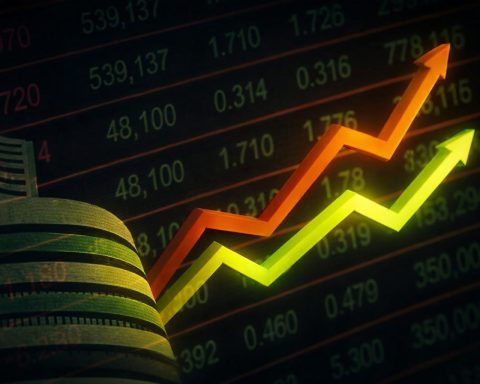- Stock (Ticker): SPCE (Virgin Galactic Holdings, NYSE).
- Price (Oct 18, 2025): ~$4.08, down 7.9% on Oct. 18 [1] (52-week range $2.18–$8.17 [2]; market cap ≈$255M [3]).
- Recent Movement: Shares spiked ~40% in early October 2025 (peaking near $4.89 on Oct. 16 [4]) before profit-taking drove a sharp pullback to ~$4.08 [5]. Heavy trading and high short interest have made SPCE extremely volatile [6] [7].
- Financials: Q2 2025 revenue only ~$0.4M (vs $4.2M in Q2 2024) [8]; net loss ~$67M [9]. Cash on hand was $508M as of June 30, 2025 [10], enough for ~18 more months at current burn rate.
- Growth Plans: Virgin is developing its next-gen “Delta Class” spaceplanes, targeting first flights in late 2026 [11]. Delta ships are being designed for far more frequent flights (8+/month) and greater capacity than the current SpaceShipTwo vehicle [12] [13].
- Upcoming Milestones: A Q3 2025 earnings call is due early November – investors will watch for updates on Delta development and cash usage [14]. In the meantime, Virgin plans one more spaceflight this year before pausing for upgrades [15], and has announced a research mission (“Purdue 1”) for 2027 [16].
- Analysts: Wall Street consensus is Neutral/Hold with average 12-month price targets around $4–$5 [17]. Notably, Bernstein and Morgan Stanley recently cut targets to ~$2–$2.50 on cash-burn worries [18]. Bullish investors point to a hefty backlog (~750 future tickets) [19] and potential market growth, while bears stress dilution risk and execution delays.
SPCE’s October Volatility: Surge and Selloff
In mid-October 2025, Virgin Galactic’s stock was a top mover in the market. After languishing in the low-$3 range, SPCE shares rallied over 40% in early October on a wave of positive news [20]. For example, on Oct. 16 alone the stock jumped about 6% intraday. Trading volume exploded as speculative traders piled in on hopes of new catalysts [21] [22]. However, this enthusiasm was met by profit-taking almost immediately: by Oct. 17 the stock plunged 7.9%, erasing much of the gains and closing around $4.08 [23] [24]. The volatile swings were driven by Virgin’s history of boom‑bust moves and heavy short interest (over 20% of float) [25] [26]. As TS2.tech noted, SPCE’s rollercoaster ride reflects its “high beta” nature – it “rockets upward on good news (a short squeeze effect) and then just as swiftly comes back to earth” [27]. On Oct. 18 the Reuters market page listed SPCE at $4.08 (down 7.9% for the day) [28], far below its peaks of 2021 but still substantially above the mid-2025 lows.
Business News Driving the Buzz
Investors have been reacting more to headlines than fundamentals. Two October announcements in particular grabbed attention. First, Virgin Galactic quietly settled a long-running shareholder lawsuit in late September. The suit had accused the company of hiding engineering issues during its SPAC merger; Virgin agreed to a ~$2.9M settlement (mostly covered by insurance) to put the issue behind it [29]. This removal of “headline risk” was seen as positive for sentiment.
Second, Virgin launched a Purdue University partnership dubbed Purdue 1. Purdue announced it will send an all-Purdue team of five researchers and alumni on a Virgin Galactic flight in 2027 [30]. Virgin Galactic’s President Mike Moses (a Purdue alum) called the mission “a powerful demonstration of what becomes possible when research institutions and educators gain direct access to the microgravity environment” [31]. He added that by letting scientists “accompany and interact with their experiments in real time, we are not just advancing science — we are empowering the next generation of innovators” [32]. This education-focused mission generated feel-good publicity that likely helped fuel the mid-October stock rally. In effect, investors were suddenly hopeful that Virgin Galactic could diversify beyond ultra-rich tourists into government and academic research payloads.
However, the financial reality has not changed dramatically. Virgin Galactic remains essentially pre-revenue. In Q2 2025 it reported only $0.4 million in revenue (down from $4.2M a year earlier due to a pause in flights) [33]. Yet its expenses are huge: the same quarter saw a net loss of about $67 million [34]. As TS2 noted, Virgin is burning roughly $100–125 million per quarter. With ~$508M cash on hand (June 2025 balance sheet), the runway is roughly 18 months [35]. In other words, if spending continues at this pace, Virgin Galactic could need more capital by late 2026 – coincidentally when its new Delta fleet is supposed to enter service. Management has acknowledged the need to possibly raise additional funds (around $300M more) to bridge the gap [36] [37].
Operations and the Space Tourism Market
Virgin Galactic’s core business is suborbital space tourism: flying civilians and researchers on a few minutes of weightlessness atop its SpaceShipTwo rocket plane. After years of delays, the company finally reached routine commercial flights in 2023–2024. By late 2025, seven commercial missions have been completed (with Galactic 07 flying in late Sept 2025) [38]. Virgin has been launching about one mission per month through 2025 [39] [40]. Each SpaceShipTwo can carry up to six people (4–6 passengers plus pilots), and flights depart from Spaceport America, New Mexico. The recent Gal07 mission, for example, carried three research passengers from Purdue [41]. Virgin plans only one more flight this year before pausing operations to perform maintenance and focus on the next-gen ships [42].
Unlike orbital tourism (SpaceX Crew Dragon flights), suborbital tourism is a very small market – but it’s growing. UBS projects the entire space tourism market could reach about $3 billion by 2030 [43]. Virgin hopes to capture much of that by appealing to wealthy adventurers and research projects. It currently charges around $450,000 per seat (with prior windows as low as $250k) and plans to increase ticket prices for the new Delta class (Bloomberg reported Virgin will raise fares when sales resume in 2026) [44] [45]. More ambitiously, industry analysts have suggested that if high-speed spacepoint-to-spacepoint travel ever materializes, the long-term market could be even larger (UBS estimates ~$20B/year for such travel in a decade [46]).
Virgin’s strategy hinges on the Delta Class spacecraft it is building. In May 2024 Virgin announced a new ground-test “Iron Bird” rig and that “the team has hit the ground running… shaving years off the development timeline” [47]. The press release notes the Delta vehicles are being designed to fly eight missions per month (about 12× the monthly capacity of the current Unity spaceship) [48]. Management’s latest outlook confirms commercial flights (both tourist and research) are targeted for fall 2026 [49]. When operational, Virgin projects about 125 flights per year at roughly $600k per seat – implying ~$450M annual revenue once two Delta ships fly [50]. That would be orders of magnitude above today’s revenue, reflecting both the promise and the current gulf to that goal.
Virgin does not have this suborbital market to itself. Competitor Blue Origin (Jeff Bezos’s company) has resumed regular tourist flights on its New Shepard rocket. In October 2025 Blue Origin successfully flew its 15th crewed tourist mission [51] [52]. New Shepard seats six and launches vertically, whereas Virgin’s spaceship is air-launched from a carrier plane. (Unlike suborbital players, SpaceX focuses on orbital tourism – e.g. Crew Dragon missions for days-long trips – and is rapidly scaling that, but Virgin is in a different segment.) Overall the space tourism industry is moving from hype toward reality: “the first tourist spaceflights” success has been called a breakthrough [53], and each launch acts as a step toward more routine service. As one analyst summed up Virgin Galactic’s mission: to eventually make “spaceflight… a routine luxury experience rather than a one-time rarity” [54]. The near-term challenge is turning that vision into paid flights.
Wall Street’s Take: Bullish Hopes vs. Bearish Risks
Given the mixed news, analysts are cautious. The consensus “Street” rating is Neutral/Hold [55]. As of mid-Oct 2025, the average 12-month price target sits around the mid-$4s [56] – essentially no big upside from the trading range. For example, Susquehanna recently reaffirmed a neutral stance with a $4.00 target [57]. In the aftermath of Q2 results, hardline firms have become bearish: Bernstein cut its 12-month target to just $2.00 (Underperform) and Morgan Stanley lowered it to $2.50 (Underweight) [58]. These banks cited the massive ongoing cash burn and long wait for revenue. On the flip side, a few investors see optionality: bulls note Virgin’s ~750-person reservation backlog as a demand signal [59], and some speculative notes (e.g. a past Goldman Sachs model) even pitched targets as high as $36 on a “best case” scenario [60].
Industry observers also highlight how sentiment drives SPCE. There’s “no shortage of skeptics,” as fintech site Finimize noted – by late Sept 2025 roughly 20–30% of SPCE shares were sold short [61]. This skepticism is a double-edged sword: it keeps many investors on edge, but it also means positive news can spark short-covering rallies. Indeed, the dramatic one-day gains in late Sept were partly attributed to a short squeeze and viral social-media buzz [62]. In the words of one Wall Street analyst: Virgin Galactic’s story is still “a severe cash burn and uncertain path to profitability” [63].
Ultimately, forecasts for SPCE are all over the map. If Virgin delivers Delta-class flights on time and hits its revenue assumptions, the stock could zoom higher. But if delays persist or funding needs grow, the stock could sink into single digits. As TS2.tech concluded, SPCE today is a “high-risk, high-reward scenario.” The recent legal wins and Purdue mission are encouraging signs, but investors will want to see concrete progress (e.g. on Delta development and ticket sales) before bidding the stock to new highs. Until then, the market’s love-hate relationship with Virgin Galactic is likely to continue.
Sources: Virgin Galactic’s financial filings and press releases [64] [65]; Reuters and TS2.tech news reports [66] [67] [68]; expert analysis on space tourism from TS2.tech and Space.com [69] [70]; industry market forecasts [71] [72], and other credible media. These highlight both the excitement of a growing space-tourism industry and the cautions around Virgin Galactic’s current financial and operational challenges.
References
1. www.reuters.com, 2. www.reuters.com, 3. www.reuters.com, 4. ts2.tech, 5. ts2.tech, 6. ts2.tech, 7. ts2.tech, 8. press.virgingalactic.com, 9. ts2.tech, 10. ts2.tech, 11. press.virgingalactic.com, 12. investors.virgingalactic.com, 13. press.virgingalactic.com, 14. ts2.tech, 15. ts2.tech, 16. www.space.com, 17. ts2.tech, 18. ts2.tech, 19. ts2.tech, 20. ts2.tech, 21. ts2.tech, 22. www.reuters.com, 23. ts2.tech, 24. www.reuters.com, 25. ts2.tech, 26. ts2.tech, 27. ts2.tech, 28. www.reuters.com, 29. ts2.tech, 30. www.space.com, 31. www.space.com, 32. www.space.com, 33. press.virgingalactic.com, 34. ts2.tech, 35. ts2.tech, 36. ts2.tech, 37. ts2.tech, 38. ts2.tech, 39. ts2.tech, 40. ts2.tech, 41. www.space.com, 42. ts2.tech, 43. www.worldfinance.com, 44. press.virgingalactic.com, 45. www.worldfinance.com, 46. www.worldfinance.com, 47. investors.virgingalactic.com, 48. investors.virgingalactic.com, 49. press.virgingalactic.com, 50. ts2.tech, 51. ts2.tech, 52. ts2.tech, 53. www.worldfinance.com, 54. ts2.tech, 55. ts2.tech, 56. ts2.tech, 57. ts2.tech, 58. ts2.tech, 59. ts2.tech, 60. ts2.tech, 61. ts2.tech, 62. ts2.tech, 63. ts2.tech, 64. press.virgingalactic.com, 65. press.virgingalactic.com, 66. www.reuters.com, 67. ts2.tech, 68. ts2.tech, 69. www.space.com, 70. ts2.tech, 71. www.worldfinance.com, 72. www.worldfinance.com









